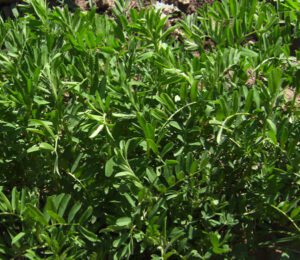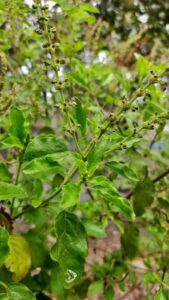Commercial or large scale coriander farming is a very common and popular business in many countries around the world. It is very common and popular as vegetable and also consumed raw. Coriander is an annual herb in the family Apiaceae. It is also known by some other names such as Dhania, Cilantro, Chinese parsley, kothmir etc. All parts of the coriander plant are edible, but the fresh leaves and the dried seeds are the most common parts which are most traditionally used in cooking.
Most people perceive coriander as having a tart, lemon/lime taste, but to nearly a quarter of those surveyed, the leaves taste like dish soap, linked to a gene that detects some specific aldehydes that can produce soapy sensation from the odorant substances.[1]
Coriander is native to the regions spanning from Southern Europe and Northern Africa to Southwestern Asia. This herb is most commonly used to flavor dishes internationally. Coriander is a soft plant growing to about 20 inches tall. The leaves of the plant are variable in shape, broadly lobed at the base of the plant, and slender and feathery higher on the flowering stems.
Coriander roots have a deeper, more intense flavor than the leaves, and are used in a variety of Asian cuisines, especially in Thai dishes such as soups or curry pastes. However, both coriander leaves and seeds have very good demand and value in the market. And starting commercial coriander farming is very easy and simple.
Uses of Coriander
The fresh leaves and the dried seeds of coriander are the parts most commonly used in cooking. But all parts of the coriander plant are edible and the roots are an important element of Thai cooking. Coriander is actually used in cuisines throughout the world.

Coriander Nutrition
Coriander is very nutritious and it is very healthy for human health. Raw coriander leaves are less than 1% fat, 2% protein, 4% carbohydrates and about 92% water. But the nutritional profile of coriander seeds is different from the fresh stems or leaves. In a 100 gram leaves are particularly rich in vitamin A, vitamin C and vitamin K with moderate content of dietary minerals. But the seeds generally have lower vitamin content, and they provide significant amounts of dietary fiber, calcium, iron, selenium, manganese and magnesium.
Health Benefits of Coriander
As we have mentioned previously, coriander is very nutritious and good for your health. Here we are trying to describe the top health benefits of coriander. Consuming coriander on a regular basis may lower blood sugar by activating certain enzymes. It’s powerful enough and people with low blood sugar level should use it cautiously.
- According to healthline, coriander is full of antioxidants. And these antioxidants demonstrate immune-boosting, anticancer, anti-inflammatory and neuroprotective effects.
- Regular consumption of coriander may help you to lower blood pressure and LDL bad cholesterol and increasing HDL good cholesterol. And thus consumption of coriander may help to protect your heart.
- A spice-rich diet with coriander appears to be associated with a lower risk of heart disease.
- As you know, coriander is rich in antioxidants, and this antioxidants may help to reduce brain inflammation, improve memory and reduce anxiety symptoms.
- Coriander exhibits antimicrobial effects that may help fight food borne illnesses and pathogens like Salmonella.
- Consumption of coriander may boost appetite among some people, and it may reduce unpleasant digestive symptoms like bloating and discomfort.
- Antioxidants available in coriander may protect your skin from aging and sun damage, it may also help to treat mild skin rashes.
Advantages of Coriander Farming Business
Like many other vegetable or crop farming business, commercial coriander farming business has also numerous advantages. Here we are trying to describe the top advantages of commercial coriander farming business.
- Commercial coriander farming is a very old and common business in many countries around the world.
- Commercial production of coriander is very easy and simple. Even the beginners can also start this business without much efforts.
- Large scale coriander farming is a very profitable business, and it is an excellent way for generating good profits.
- Large scale coriander farming is an established business, so you don’t have to worry much about starting and operating this business.
- Coriander plants grow rapidly and they are very strong and hardy. You will get back your invested money within a very short period of time.
- Both demand and value of coriander are good in the market. So, you will be able to make good profits from this business.
- Commercial coriander production is highly profitable. So it can be a great employment source for the people, especially for the educated but unemployed people.
- Production costs in commercial coriander farming business is very less, but profit is good.
- Coriander is very nutritious and good for health. And you can enjoy fresh coriander if you start your own production.
How to Start Coriander Farming
Starting commercial coriander farming business is very simple and easy. It’s just like starting other crop or vegetable farming business. You can start this business easily, even if you are a beginner. But we recommend having practical knowledge/experience before starting this business commercially. Here we are trying to describe more information about starting and operating this business from planting, caring to harvesting and marketing.
Site Selection
Coriander plants can be grown in almost all types of soil. But the plants generally grow well in well drained and loamy soil. Ideal pH range of the soil should be between 8 and 10.
Prepare the Soil
You have to prepare the soil perfectly before sowing coriander seeds. Give 2-3 ploughing followed by planking to make uniform and leveled beds. Add as much organic contents as you can while preparing the soil. Adding about 4 tons of well decomposed cow dung into the soil before last ploughing will be good.
Climate Requirement For Coriander Farming
Coriander plants generally grow well in dry and cool weather condition. The plants can’t tolerate frost. These plants can perform well at a temperate range between 20°C and 30°C. June to July and October to November is the best time for growing coriander.
Choose a Variety
There are many local and hybrid varieties of coriander available to choose from. You can choose any variety depending upon it’s growing ability and availability in your area. You can consult with a local expert in your area for having better recommendations.
Propagation
Propagation of coriander plants is generally done by seeds.
Purchase Seeds
Coriander seeds are highly available in the market. You can purchase the seeds from any of your nearest seed supply store. You can also consider purchasing online.
Planting
Optimum time for sowing coriander seeds for vegetable purpose is first week of October. And when you will grow coriander for seeds purpose, complete sowing in last week of October to first week of November. Keep 30 cm spacing between row to row and 15 cm spacing between plant to plant. Sowing depth should not more than 3cm. Soak the seeds in water for 12 hours for better germination. And treat the seeds with Azospirillum at the rate of 1.5 kg per hectare for You will need about 20-25 kg of seeds per hectare in rainfed condition, and between 10 and 12 kg per hectare in irrigated crop condition.
Caring
The coriander plants generally require less caring and other management. Although taking additional care will help the plants to grow well and produce more. Here we are trying to describe more about the caring process of the coriander plants.
Fertilizing: Apply Nitrogen at the rate of 40kg in the form of Urea at the rate of 90kg per acre in three splits. Apply half at the time of sowing and remaining in two equal splits after first and second cutting of leaves. When crop is grown for seed purpose, apply Nitrogen at the rate of 30kg per acre i.e 65kg per acre in two doses, half at sowing time and remaining at time of flower initiation.
Watering: Provide irrigation according to soil moisture present in the soil. Provide first irrigation immediately after sowing the seeds, and provide subsequent irrigation at 10 to 12 days interval.
Controlling Weeds: Weeds consume nutrients from the soil. So, it’s very important to control them. Take one or two weeding operations to keep field weed free. Perform first weeding 4 week after sowing and second weeding 5-6 weeks after sowing.
Pests & Diseases
Like many other commercial crops, the coriander plants are also susceptible to some common pests and diseases. Here we are shortly describing about the common pests and diseases of the coriander plants.
Common Diseases And Their Control: Common diseases of the coriander plants are grain mould, powdery mildew and root rot. Consult with an expert in your area for better suggestion.
Common Pests And Their Control: Aphid is the most common pest of the coriander plant. If you observe infestation of Aphid, take spray of Imidacloprid at the rate of 6ml per liter water or Thiamethoxam at the rate of 4 gram per 10 liter of water.
Harvesting
You can start harvesting coriander when the crop attain 20-25 cm height. 3-4 cutting can be taken. If you grow coriander for seed purpose, then it will be ready for harvesting in April month.
Yield
It’s very tough to tell the exact amount. On an average, you can expect 6 to 7 tonnes of leaf from one hectare. Seeds production will be between 500 to 600 kg per hectare in irrigated condition, and between 300 and 400 kg in rainfed condition.
Marketing
Marketing coriander is very easy and simple. You will be able to sell coriander as vegetable in your local market. Although, you should set your marketing strategies before starting this business.
These are the common steps and ways for starting and operating a successful coriander farming business. Hope this guide has helped you! Good luck and may God bless you!





